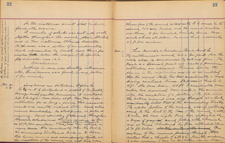
Vanished Worlds, Enduring People
Anthropologists & Native Americans
Clarence B. Moore. Notebooks. Mandarin Point, Duval County, St. John’s River, Fla., Nov. 4, 1893. [view]
Clarence B. Moore (1852-1936) was a wealthy amateur archaeologist from Philadelphia who crisscrossed the rivers of the southeast each year in his steam-powered paddleboat, the Gopher, excavating sites near the shores in states ranging from Alabama to Tennessee. During his twenty years of investigations, Moore explored an astounding number of archaeological sites. He published the results of his investigations regularly, translating the field notes he kept in small journals into the larger, neatly written notebooks that he later used as the basis for his publications.
During his excavations, Moore uncovered many artifacts associated with Indian burials that later ended up in museums. These artifacts are now subject to repatriation by tribal members working to reclaim their sacred heritage. Natives and non-natives alike rely on Moore’s “Field Notes,” which can provide important clues about the history of an artifact, helping to further repatriation claims.